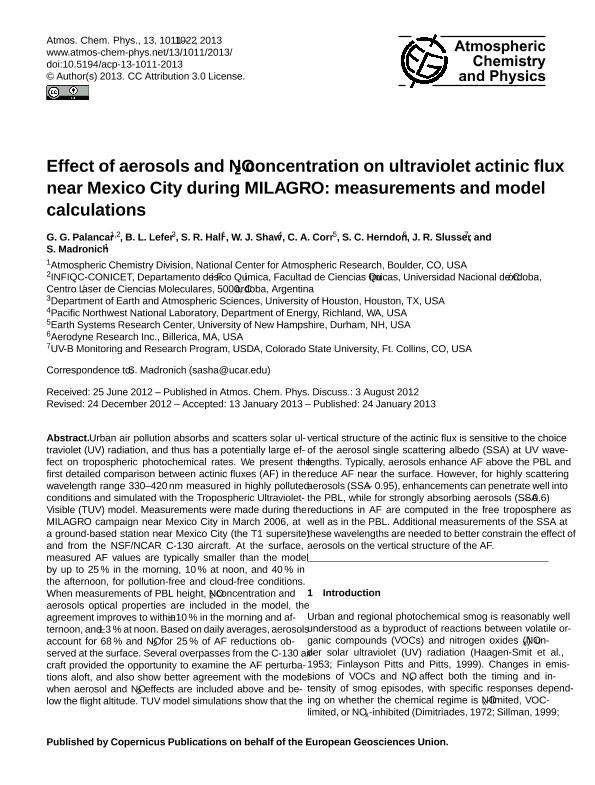Artículo
Effect of aerosols and NO2 concentration on ultraviolet actinic flux near Mexico City during MILAGRO: measurements and model calculations
Palancar, Gustavo Gerardo ; Lefer, B. L.; Hall, S. R. ; Shaw, W. J.; Corr, C. A. ; Herndon, S. C. ; Slusser, J. R.; Madronich, S.
; Lefer, B. L.; Hall, S. R. ; Shaw, W. J.; Corr, C. A. ; Herndon, S. C. ; Slusser, J. R.; Madronich, S.
 ; Lefer, B. L.; Hall, S. R. ; Shaw, W. J.; Corr, C. A. ; Herndon, S. C. ; Slusser, J. R.; Madronich, S.
; Lefer, B. L.; Hall, S. R. ; Shaw, W. J.; Corr, C. A. ; Herndon, S. C. ; Slusser, J. R.; Madronich, S.
Fecha de publicación:
01/2013
Editorial:
Copernicus Publications
Revista:
Atmospheric Chemistry and Physics
ISSN:
1680-7316
e-ISSN:
1680-7324
Idioma:
Inglés
Tipo de recurso:
Artículo publicado
Clasificación temática:
Resumen
Urban air pollution absorbs and scatters solar ultraviolet (UV) radiation, and thus has a potentially large effect on tropospheric photochemical rates. We present the first detailed comparison between actinic fluxes (AF) in the wavelength range 330–420 nm measured in highly polluted conditions and simulated with the Tropospheric UltravioletVisible (TUV) model. Measurements were made during the MILAGRO campaign near Mexico City in March 2006, at a ground-based station near Mexico City (the T1 supersite) and from the NSF/NCAR C-130 aircraft. At the surface, measured AF values are typically smaller than the model by up to 25 % in the morning, 10 % at noon, and 40 % in the afternoon, for pollution-free and cloud-free conditions. When measurements of PBL height, NO2 concentration and aerosols optical properties are included in the model, the agreement improves to within ±10 % in the morning and afternoon, and ±3 % at noon. Based on daily averages, aerosols account for 68 % and NO2 for 25 % of AF reductions observed at the surface. Several overpasses from the C-130 aircraft provided the opportunity to examine the AF perturbations aloft, and also show better agreement with the model when aerosol and NO2 effects are included above and below the flight altitude. TUV model simulations show that the vertical structure of the actinic flux is sensitive to the choice of the aerosol single scattering albedo (SSA) at UV wavelengths. Typically, aerosols enhance AF above the PBL and reduce AF near the surface. However, for highly scattering aerosols (SSA > 0.95), enhancements can penetrate well into the PBL, while for strongly absorbing aerosols (SSA < 0.6) reductions in AF are computed in the free troposphere as well as in the PBL. Additional measurements of the SSA at these wavelengths are needed to better constrain the effect of aerosols on the vertical structure of the AF.
Palabras clave:
Actinic Flux
,
México City
,
Milagro Campaign
,
Aerosols And No2 Concentration
Archivos asociados
Licencia
Identificadores
Colecciones
Articulos(INFIQC)
Articulos de INST.DE INVESTIGACIONES EN FISICO- QUIMICA DE CORDOBA
Articulos de INST.DE INVESTIGACIONES EN FISICO- QUIMICA DE CORDOBA
Citación
Palancar, Gustavo Gerardo; Lefer, B. L.; Hall, S. R. ; Shaw, W. J.; Corr, C. A. ; et al.; Effect of aerosols and NO2 concentration on ultraviolet actinic flux near Mexico City during MILAGRO: measurements and model calculations; Copernicus Publications; Atmospheric Chemistry and Physics; 13; 1-2013; 1011-1022
Compartir
Altmétricas



